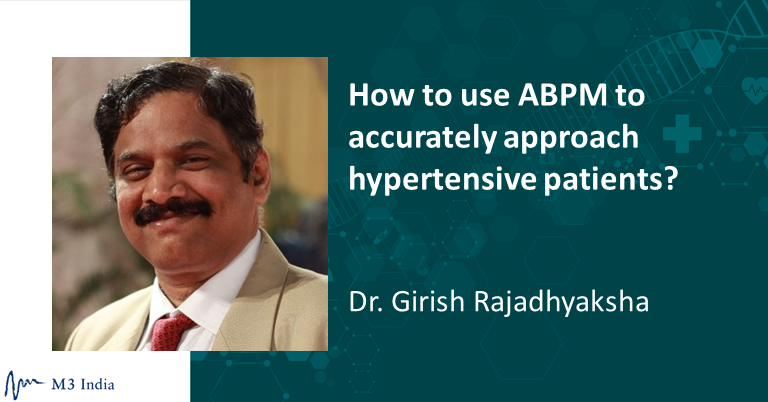How to use ABPM to accurately approach hypertensive patients?: Dr. Girish Rajadhyaksha
M3 India Newsdesk Jul 23, 2019
Dr. Girish Rajadhyaksha writes on Ambulatory Blood Pressure Monitoring (ABPM) and how it allows for more accurate planning of treatment regimen based on blood pressure patterns in hypertensive patients as opposed to reliance on clinic blood pressure that may result in substantial overdiagnosis.

Before the early 1970s, intra-arterial recordings provided the only means of following up with changes in blood pressure (BP) during the typical activities of daily living over a period of time. The development and commercial availability of lightweight, quiet, easy-to-wear, automated, non-invasive BP recorders has facilitated the collection of large volumes of data while a subject pursues his or her everyday activities.
Data derived from ambulatory BP monitoring (ABPM) have made important contributions to our understanding of the pathophysiology of hypertension and its complications, the definition of daytime and night-time normotension, the prognostic value of ambulatory BP, and the evaluation of therapies.
Blood pressure follows a highly reproducible pattern characterised by:
- a low period during sleep
- an early morning, post-awakening rise, coinciding with the transition from sleep to wakefulness
- a higher, sustained and more variable period thereafter
The circadian variation in BP and its association with cardiovascular events, including both myocardial infarction and stroke, are well-established.
The term 'non-dippers' was coined by O’Brien to describe those individuals in whom the decline in night-time BP is less than 10% of the day- time value; such people were found to be at increased risk for stroke. There is strong evidence that a persistent non-dipping pattern is associated with more pronounced cardiac involvement, particularly left ventricular hypertrophy (LVH).
It has been proposed that the non-dipping pattern may be associated with atherosclerosis, cardiovascular, and kidney disease. Even among patients with treated hypertension, half do not adequately drop their nocturnal BPs. After adjusting for age, sex, and diabetes, a mean 5 mmHg reduction in systolic nocturnal BP is associated with a 17% drop in cardiovascular risk.
The Spanish ABPM Registry shows that the use of ABPM in clinical practice may double the rates of hypertension control. The findings of both the Office versus Ambulatory Blood Pressure Study and the Spanish registry support more extensive utilisation of ABPM in clinical practice. In the UnitedKingdom and Canada, ABPM is recommended in all adults to confirm the diagnosis of hypertension
It has been suggested that the current reliance on clinic blood pressure alone might result in substantial overdiagnosis of hypertension; ambulatory monitoring might allow for more appropriate targeting of patients most likely to benefit from lifelong drug treatment.
The USPSTF (United States Preventive Services Special Task Force) found convincing evidence that ABPM is the best method for diagnosing hypertension. Although the criteria for establishing hypertension varied across studies, there was significant discordance between the office diagnosis of hypertension and 12- and 24-hour average BP using ABPM.
Advantages of ambulatory blood pressure monitoring over clinic blood pressure
- Gives a larger number of readings than office blood pressure measurement
- Provides a profile of blood pressure behavior in the patient’s usual daily environment
- Allows identification of white-coat and masked hypertension phenomena
- Demonstrates nocturnal hypertension
- Assesses blood pressure variability over the 24-hour period
- Assesses the 24-hour efficacy of antihypertensive medication
- Is a stronger predictor of cardiovascular morbidity and mortality than office measurement
Thresholds for hypertension diagnosis based on ambulatory blood pressure monitoring
- 24-hour average: >130/80 mmHg
- Awake (daytime) average: >135/85 mmHg
- Asleep (night-time) average: >120/75 mmHg
Disclaimer- The views and opinions expressed in this article are those of the author's and do not necessarily reflect the official policy or position of M3 India.
The author is a professor of Internal Medicine at a reputed government medical college and hospital in Mumbai.
-
Exclusive Write-ups & Webinars by KOLs
-
Daily Quiz by specialty
-
Paid Market Research Surveys
-
Case discussions, News & Journals' summaries
